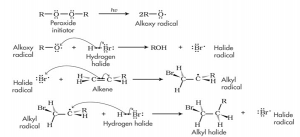Anti Markovnikov addition is one of the most important reactions following free radical mechanism in JEE syllabus. This reaction is also known as Kharash effect or peroxide effect. Some FAQs related to Anti Markovnikov addition are given below:
Frequently Asked Questions on Anti-Markovnikov Addition
Question: What is anti-Markovnikov addition?
Answer: When HBR is added to unsymmetrical alkenes in the presence of peroxide, 1-bromopropane is formed contrary to 2-bromopropane (according to Markovnikov’s rule). This reaction mechanism is known as Anti Markovnikov addition or Kharash effect. It was named after a pioneering organic chemist M. S. Kharash who first observed it.
*This reaction is observed only with HBr, not with HCl or HI
Questions: What is the general mechanism of anti-Markovnikov addition?
Answer: Anti Markovnikov addition reaction is found to follow a free radical mechanism. The peroxide compound involved helps in the generation of free radicals. A general mechanism of Anti Markovnikov addition reaction is discussed below:
- Generation of free radical through homolytic cleavage of peroxide compound.
- Attack of generated free radical on hydrogen halide to form halide radical through homolysis
- Attack of generated halide radical on alkene molecule to form alkyl radical through homolysis.
- Attack of the generated alkyl radical on hydrogen halide to form alkyl halide through homolytic cleavage of hydrogen halide bond.

Fig: Anti Markovnikov addition mechanism
Questions: Which reference books can one refer to learn more about Anti Markovnikov addition?
Answer: For understanding the Anti Markovnikov addition reaction, one must go through the NCERT class 11th chemistry textbook part-2. A brisk walk through hydrocarbons from NCERT will give you a sound idea of the addition reaction of unsymmetrical alkenes.
Alternatively, you can follow a reference book to understand the rule in details. Some authentic books for understanding this rule include books from authors like Solomons & Fryhle, Morrison & Boyd. Once you have developed concepts on this topic, you can practice questions from the books of authors like M. S. Chauhan, etc.
Click here to learn more about important JEE Chemistry topics.
Comments